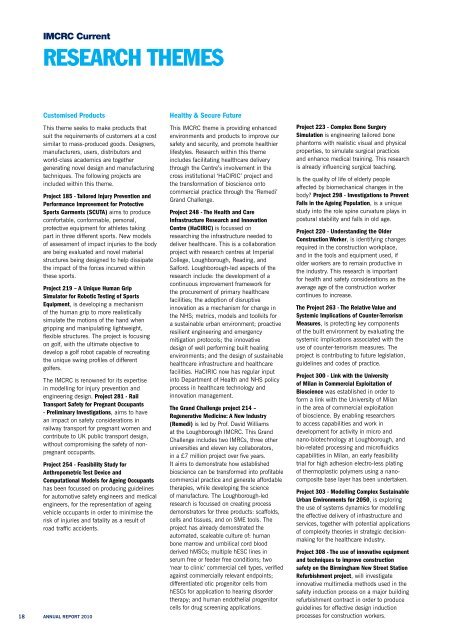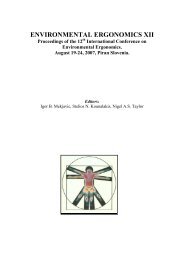ANNUAL REPORT 2010 - Loughborough University
ANNUAL REPORT 2010 - Loughborough University
ANNUAL REPORT 2010 - Loughborough University
You also want an ePaper? Increase the reach of your titles
YUMPU automatically turns print PDFs into web optimized ePapers that Google loves.
18<br />
IMCRC Current<br />
RESEARCh ThEMES<br />
Customised Products<br />
This theme seeks to make products that<br />
suit the requirements of customers at a cost<br />
similar to mass-produced goods. Designers,<br />
manufacturers, users, distributors and<br />
world-class academics are together<br />
generating novel design and manufacturing<br />
techniques. The following projects are<br />
included within this theme.<br />
Project 185 - Tailored Injury Prevention and<br />
Performance Improvement for Protective<br />
Sports garments (SCUTA) aims to produce<br />
comfortable, conformable, personal,<br />
protective equipment for athletes taking<br />
part in three different sports. New models<br />
of assessment of impact injuries to the body<br />
are being evaluated and novel material<br />
structures being designed to help dissipate<br />
the impact of the forces incurred within<br />
these sports.<br />
Project 219 – A Unique human grip<br />
Simulator for Robotic Testing of Sports<br />
Equipment, is developing a mechanism<br />
of the human grip to more realistically<br />
simulate the motions of the hand when<br />
gripping and manipulating lightweight,<br />
flexible structures. The project is focusing<br />
on golf, with the ultimate objective to<br />
develop a golf robot capable of recreating<br />
the unique swing profiles of different<br />
golfers.<br />
The IMCRC is renowned for its expertise<br />
in modelling for injury prevention and<br />
engineering design. Project 281 - Rail<br />
Transport Safety for Pregnant occupants<br />
- Preliminary Investigations, aims to have<br />
an impact on safety considerations in<br />
railway transport for pregnant women and<br />
contribute to UK public transport design,<br />
without compromising the safety of nonpregnant<br />
occupants.<br />
Project 254 - Feasibility Study for<br />
Anthropometric Test Device and<br />
Computational Models for Ageing occupants<br />
has been focussed on producing guidelines<br />
for automotive safety engineers and medical<br />
engineers, for the representation of ageing<br />
vehicle occupants in order to minimise the<br />
risk of injuries and fatality as a result of<br />
road traffic accidents.<br />
AnnuAl RepoRt <strong>2010</strong><br />
healthy & Secure Future<br />
This IMCRC theme is providing enhanced<br />
environments and products to improve our<br />
safety and security, and promote healthier<br />
lifestyles. Research within this theme<br />
includes facilitating healthcare delivery<br />
through the Centre’s involvement in the<br />
cross institutional ‘HaCIRIC’ project and<br />
the transformation of bioscience onto<br />
commercial practice through the ‘Remedi’<br />
Grand Challenge.<br />
Project 248 - The health and Care<br />
Infrastructure Research and Innovation<br />
Centre (haCIRIC) is focussed on<br />
researching the infrastructure needed to<br />
deliver healthcare. This is a collaboration<br />
project with research centres at Imperial<br />
College, <strong>Loughborough</strong>, Reading, and<br />
Salford. <strong>Loughborough</strong>-led aspects of the<br />
research include: the development of a<br />
continuous improvement framework for<br />
the procurement of primary healthcare<br />
facilities; the adoption of disruptive<br />
innovation as a mechanism for change in<br />
the NHS; metrics, models and toolkits for<br />
a sustainable urban environment; proactive<br />
resilient engineering and emergency<br />
mitigation protocols; the innovative<br />
design of well performing built healing<br />
environments; and the design of sustainable<br />
healthcare infrastructure and healthcare<br />
facilities. HaCIRIC now has regular input<br />
into Department of Health and NHS policy<br />
process in healthcare technology and<br />
innovation management.<br />
The grand Challenge project 214 –<br />
Regenerative Medicine: A New Industry<br />
(Remedi) is led by Prof. David Williams<br />
at the <strong>Loughborough</strong> IMCRC. This Grand<br />
Challenge includes two IMRCs, three other<br />
universities and eleven key collaborators,<br />
in a £7 million project over five years.<br />
It aims to demonstrate how established<br />
bioscience can be transformed into profitable<br />
commercial practice and generate affordable<br />
therapies, while developing the science<br />
of manufacture. The <strong>Loughborough</strong>-led<br />
research is focussed on creating process<br />
demonstrators for three products: scaffolds,<br />
cells and tissues, and on SME tools. The<br />
project has already demonstrated the<br />
automated, scaleable culture of: human<br />
bone marrow and umbilical cord blood<br />
derived hMSCs; multiple hESC lines in<br />
serum‐free or feeder‐free conditions; two<br />
‘near to clinic’ commercial cell types, verified<br />
against commercially relevant endpoints;<br />
differentiated otic progenitor cells from<br />
hESCs for application to hearing disorder<br />
therapy; and human endothelial progenitor<br />
cells for drug screening applications.<br />
Project 223 - Complex Bone Surgery<br />
Simulation is engineering tailored bone<br />
phantoms with realistic visual and physical<br />
properties, to simulate surgical practices<br />
and enhance medical training. This research<br />
is already influencing surgical teaching.<br />
Is the quality of life of elderly people<br />
affected by biomechanical changes in the<br />
body? Project 298 - Investigations to Prevent<br />
Falls in the Ageing Population, is a unique<br />
study into the role spine curvature plays in<br />
postural stability and falls in old age.<br />
Project 220 - Understanding the older<br />
Construction Worker, is identifying changes<br />
required in the construction workplace,<br />
and in the tools and equipment used, if<br />
older workers are to remain productive in<br />
the industry. This research is important<br />
for health and safety considerations as the<br />
average age of the construction worker<br />
continues to increase.<br />
The Project 263 - The Relative Value and<br />
Systemic Implications of Counter-Terrorism<br />
Measures, is protecting key components<br />
of the built environment by evaluating the<br />
systemic implications associated with the<br />
use of counter-terrorism measures. The<br />
project is contributing to future legislation,<br />
guidelines and codes of practice.<br />
Project 300 - Link with the <strong>University</strong><br />
of Milan in Commercial Exploitation of<br />
Bioscience was established in order to<br />
form a link with the <strong>University</strong> of Milan<br />
in the area of commercial exploitation<br />
of bioscience. By enabling researchers<br />
to access capabilities and work in<br />
development for activity in micro and<br />
nano-biotechnology at <strong>Loughborough</strong>, and<br />
bio-related processing and microfluidics<br />
capabilities in Milan, an early feasibility<br />
trial for high adhesion electro-less plating<br />
of thermoplastic polymers using a nanocomposite<br />
base layer has been undertaken.<br />
Project 303 - Modelling Complex Sustainable<br />
Urban Environments for 2050, is exploring<br />
the use of systems dynamics for modelling<br />
the effective delivery of infrastructure and<br />
services, together with potential applications<br />
of complexity theories in strategic decisionmaking<br />
for the healthcare industry.<br />
Project 308 - The use of innovative equipment<br />
and techniques to improve construction<br />
safety on the Birmingham New Street Station<br />
Refurbishment project, will investigate<br />
innovative multimedia methods used in the<br />
safety induction process on a major building<br />
refurbishment contract in order to produce<br />
guidelines for effective design induction<br />
processes for construction workers.

















